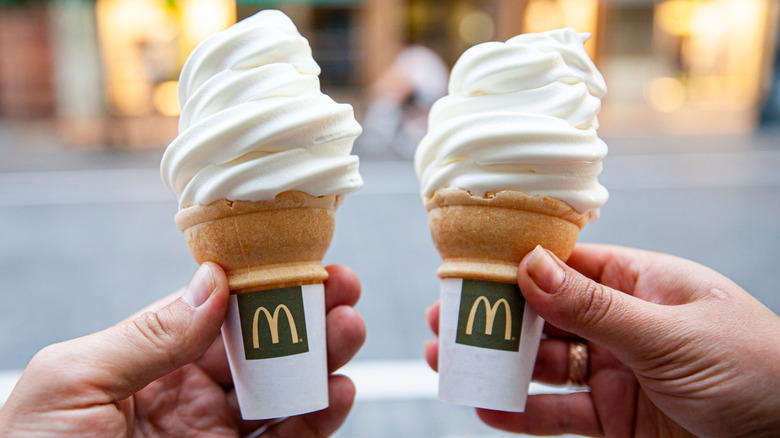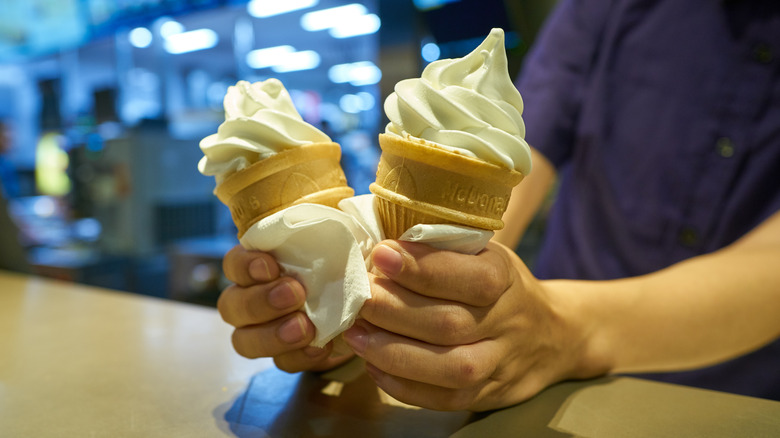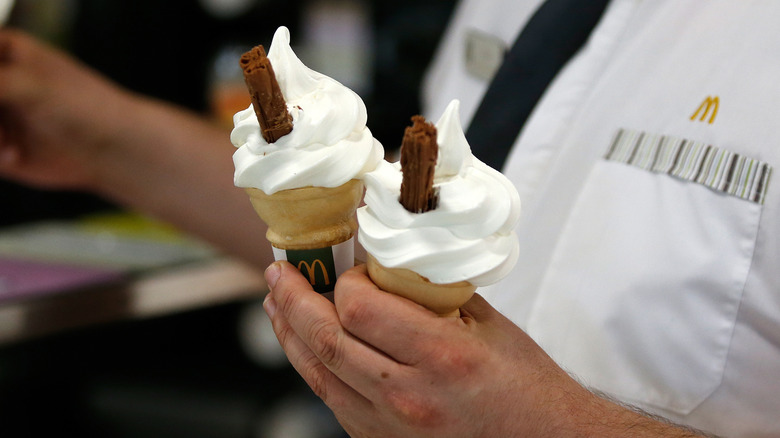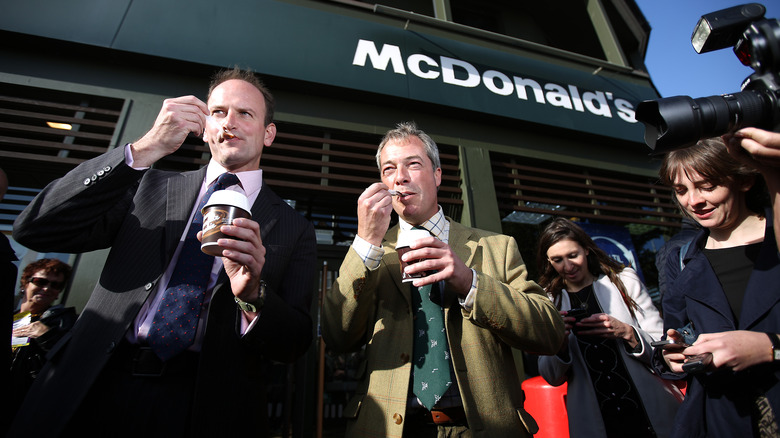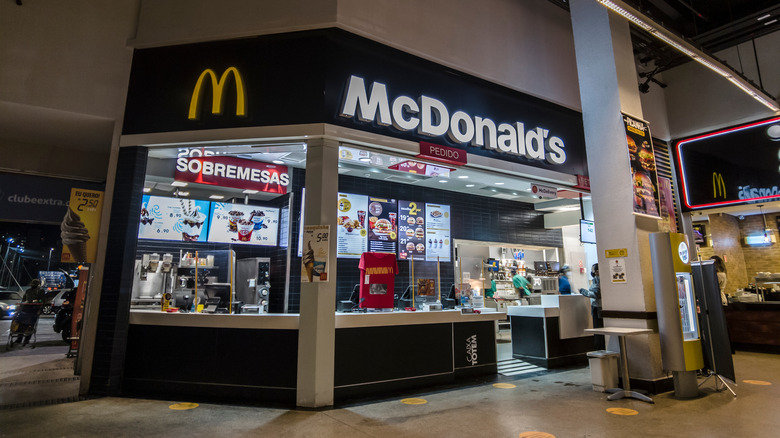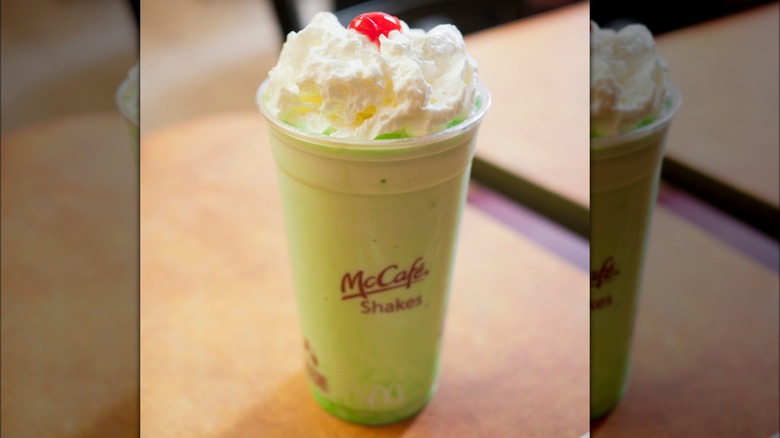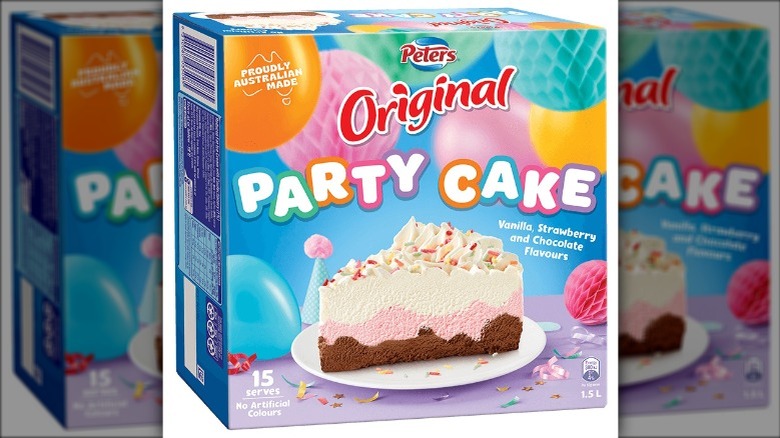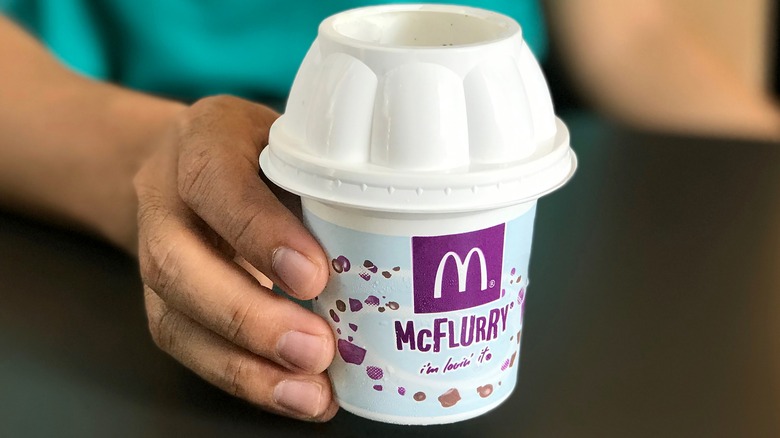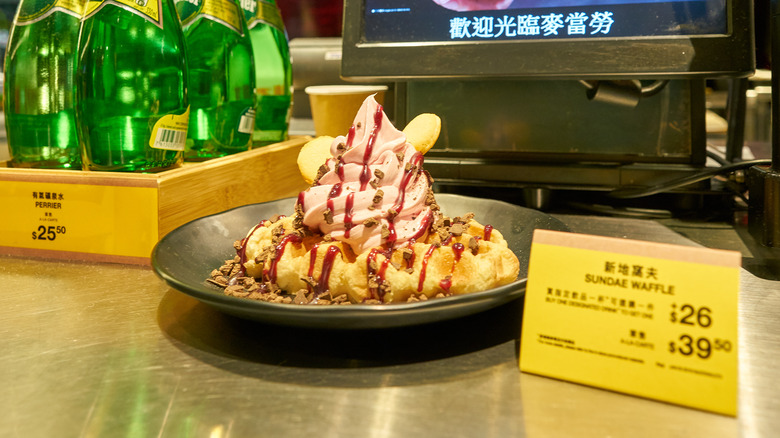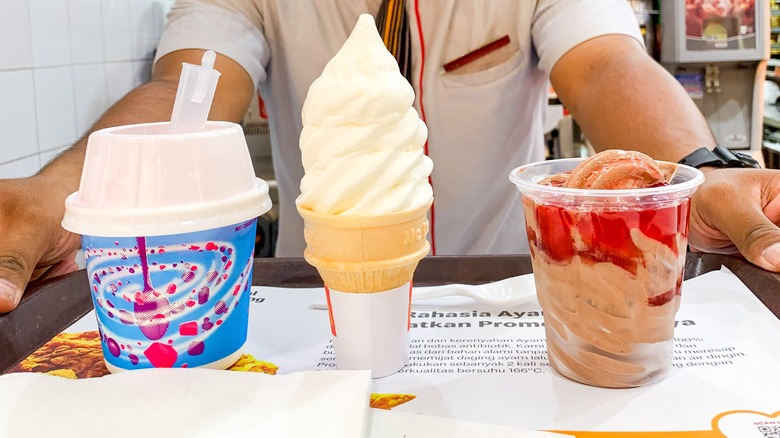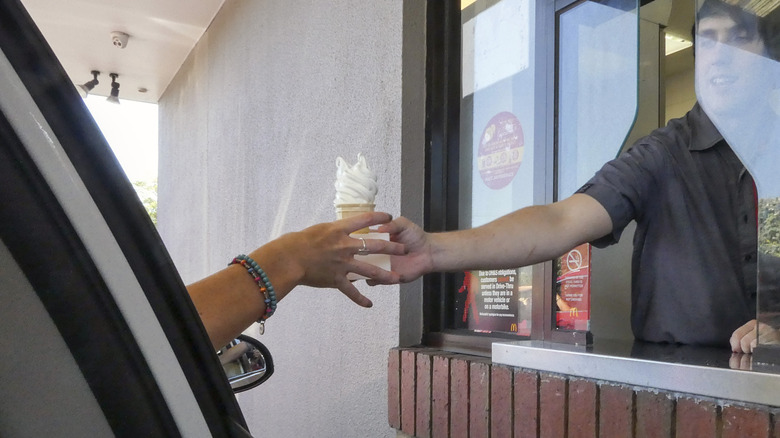All Of Your McDonald's Ice Cream Questions Answered
McDonald's ice cream is a key part of the chain's business. From the unmistakable goodness of the simple vanilla cone to the drive-through decadence of the McFlurry, customers just can't get enough of the stuff. Notably, compared to many other fast food establishments, McDonald's keeps things fairly simple. You won't find dozens of flavors, chocolate-dipped cones, or a wide variety of toppings here — just a few specific treats available in a few specific options. Even the ice cream cone itself just comes in standard vanilla.
It's rather surprising, then, that McDonald's ice cream has a somewhat mysterious reputation. Questions about the smooth soft serve proliferate by the dozen. What's up the ice cream machines, which always seem to be broken, no matter where a prospective customer travels? How many kinds of McFlurry are there? Do different countries really offer different kinds of ice cream-based treats? And seriously, what the heck is up with the broken machines? We're here with all the answers to your burning McDonald's ice cream-related questions — and maybe even a few you haven't thought to ask.
Is McDonald's ice cream real ice cream?
To answer this question, we have to answer another: What is real ice cream, anyway? Essentially, all ice cream boils down to a combination of milk, cream, sugar, flavoring, and whatever else the ice cream maker wants to throw in (chocolate chips, chopped-up cookies, berries — you get the idea). These elements are churned into the smooth, chilly treat we know and love, transferred into packaging, and frozen at or below 0 degrees Fahrenheit.
Soft serve, in contrast, is dispensed at a higher temperature — typically 20 to 25 degrees — by a specialized machine. It also usually incorporates more air, which gives the treat its airy mouthfeel (in addition to cutting costs for the producer — air is free, after all). Soft serve is also separated from ice cream by milkfat content, which is actually federally regulated. By law, all ice cream worthy of the name contains at least 10% milkfat. Some soft serve meets this requirement, but quite a lot of it — including McDonald's – does not.
So, is McDonald's soft serve real ice cream? Technically, no. The milkfat content is the most pertinent factor; that 10% requirement is unforgiving, and McDonald's sweet treat doesn't meet it. Moreover, though most people don't care too much about the nitty-gritty production differences between proper ice cream and soft serve, they remain relevant and worth examining. Let's be real, though: Most people call McDonald's soft serve "ice cream," and they're not going to stop anytime soon.
Has McDonald's ice cream always used the same recipe?
McDonald's seems eternal to the modern consumer. It's everywhere, for one thing, from Sweden's snow-covered mountains to the tiny island of Reunion. For another, it serves roughly the same menu everywhere. There are regional differences, to be sure. But, generally speaking, you'll find fries, burgers, and chicken nuggets under the golden arches, no matter what land they're standing on.
It's easy, then, to assume that McDonald's menu items have been made the exact same way for decades. But this isn't true, and the ice cream is a great example. In fall 2016, McDonald's began the process of phasing out the artificial flavors in its signature vanilla soft serve. This was part of a larger, menu-wide effort to do away with artificial elements, preservatives, and otherwise controversial ingredients; everything from Chicken McNuggets to burger buns were affected. The ice cream-centric corner of the dessert menu was particularly changed. In addition to the soft serve's new, artificial flavor-free recipe, the shake syrup lost its high-fructose corn syrup, while whipped topping became artificial color, flavor, and preservative-free.
This seems to have been a pretty painless transition, which was very much by design. "We worked closely with our culinary team to ensure taste was not impacted," senior director of menu innovation Darci Forrest told CNBC. Given the fact that sweet-toothed McDonald's fans everywhere did not rise up in protest, we'd say they accomplished their goal.
How popular is McDonald's ice cream?
When people think of McDonald's, they think of savory foods. Big Macs bursting with cheese and lettuce, golden french fries in classic red boxes, crisp McNuggets cloaked in amber sauce — that's the kind of stuff Mickey D's dreams are made of. But the sweet side of the menu is no slouch. Dessert is a key part of the McDonald's experience, and ice cream makes up a major part of it.
As senior director of menu innovation Darci Forrest told CNBC in 2017, "Last summer alone, our customers enjoyed 68 million cones at McDonald's." That's a lot of ice cream. It's also particularly impressive when considered in the context of the wider dessert menu. Note that Forrest mentions 68 million cones, specifically — as in, not McFlurries. McDonald's ice cream is so good, a lot of people opt to enjoy it unto itself, sans the McFlurry's tasty mix-ins. The humble cone also holds its own against McDonald's apple pie. This baked treat is an icon; it's been offered in more than 40 different forms, inspired its own McDonaldland character in the Apple Pie Tree, and sparked lasting controversy when it changed from being fried to baked in 1992. Yet plenty of people still choose a simple vanilla cone when they want a sweet McDonald's treat.
Why are the ice cream machines always broken?
By this point, you've probably heard about McDonald's infamously broken ice cream machines. These big hunks of metal struggle to stay operational, to the point that one industrious fan decided to create mcbroken, a website that keeps real-time track of which locations boast working ice cream machines and which do not. The front page, which reveals what percentage of machines are currently broken, is pretty damning in and of itself — the number is often in the double digits.
How have things gotten so bad? It starts with a simple fact: The vast majority of McDonald's locations use the Taylor C602 ice cream machine. These machines are prone to all sorts of issues, the two biggest being its cleaning process and opaque interface. To kill off whatever bacteria might be lurking in its many ducts and tubes, the Taylor C602 runs through a complex heating and cooling process that takes four hours. If something goes wrong — which happens fairly often — it displays uninformative error messages that leave employees with no choice but to run the entire four-hour cycle again.
You might think this is the end of the problem, but it's not. If issues persist, McDonald's workers must reach out to an authorized Taylor technician. These experts can take weeks — yes, weeks — to get there and fix the issue. Going with a non-authorized technician is a quick way of getting Taylor to void the warranty. When you look at it this way, it's almost impressive the machines ever work at all.
What's being done to fix the broken ice cream machines?
Efforts are being made to fix McDonald's finicky ice cream machines, but not all of them are created equal. The most famous, by far, is Kytch. Created by Jeremy O'Sullivan and Melissa Nelson, Kytch is a handy little device that delves past the Taylor C602's incredibly opaque error messages to deliver employees actual insight into what's going wrong inside the tricky machine. That's not all — it even suggests some solutions. Unsurprisingly, the brilliant little gadget caught on fast among McDonald's franchisees.
Eventually, McDonald's took notice — and lowered the boom. The corporation sent franchisees an email claiming Kytch devices put people's information at risk, potentially voided warranties, and could even cause injury. The next day, a Taylor-branded device much like Kytch's became available.
This isn't the end of the story, though. This entire affair has piqued the interest of the right to repair movement, which believes independent technicians and private citizens should be empowered to fix their own machines. The Biden administration has expressed particular interest in this cause, and the FTC reached out to McDonald's franchisees about the issue in 2021. Though McDonald's representatives stated that year that they don't believe the company is under investigation, per NPR, this is a story that's definitely worth keeping an eye on.
How do broken ice cream machines affect McDonald's business?
Given how frequently busted McDonald's ice cream machines are, you might assume they don't affect the bottom line all that much. If they did, this line of thinking goes, wouldn't the company be doing more to get them back in fighting shape — and making sure they stay there? There's logic to this conclusion, but it's anything from certain. In fact, there's just as much reason to believe McDonald's finicky ice cream machines make a major impact on the company's reputation and bottom line.
First off, the fact that their oft-broken status has become a meme is itself proof that a whole lot of people are paying attention. Then there's the fact that some of the company's most popular offerings are ice-cream based. Consider the Shamrock Shake. As previously explained, McDonald's ice cream machines go through a daily four-hour sanitization process. If something goes wrong, employees typically run the process again. That's eight hours of non-operation, which is bad enough at any time. But during Shamrock Shake season, when shake sales are multiplied as much as tenfold? That's a lot of money lost.
Does McDonald's ice cream contain xylitol?
If you're a dog lover, there's a significant chance that, back in 2022, you saw at least one meme, post, or video urging you to keep McDonald's ice cream — and all treats created with it — far away from your beloved pooch. Why the panic? These viral missives claimed the chain's ice cream contains xylitol.
A widely used sugar substitute, xylitol is indeed toxic to dogs; canine lovers would do well to make sure it stays far away from their furry friends. There's just one flaw in this wide-ranging online campaign: McDonald's ice cream doesn't contain xylitol. The chain made sure to point this out, telling USA Today, "Our soft serve, found in our cones and other desserts, does not contain xylitol."
Of course, feeding your dog McDonald's ice cream still isn't the best idea. A little lick here and there won't kill them, but the sugary stuff can irritate canine stomachs and shouldn't be more than an occasional treat. Still, dog owners can rest easy, knowing one particularly dangerous ingredient isn't present in McDonald's frozen desserts.
Does McDonald's offer ice cream cake?
Ice cream is delicious on its own, but one of its greatest virtues is its versatility. It tastes great in sundaes, banana splits, affogatos, and as the foundation of that venerable dessert table titan, the ice cream cake. Ice cream cake is widely beloved, but not every place that sells ice cream is ready to whip one out. They're fairly work-intensive and require precise presentation, lest they melt into a big, gooey mess. You might thus assume McDonald's has never bothered to offer ice cream cakes.
Unless, of course, you're Australian — then the story is entirely different. Denizens of the land down under — especially those who were kids in the 1990s — have fond memories of birthday parties under the golden arches, which were typically concluded with an ice cream cake. If you're not an Aussie, you're probably already feeling a little deprived. Sorry to say, it gets worse: Australian McDonald's restaurants still sell ice cream cakes, specifically Peters Original Party Cakes, for a mere $14.95.
Now, this doesn't mean you can waltz in whenever and expect to leave with an ice cream cake. The Peters ice cream cakes don't seem to be available in every McDonald's — or, as they say in Australia, "Macca's" — and it's subject to fluctuating stock. The chain recommends prospective buyers call ahead to see if their local establishment has the cake on hand. Still, it's hard not to be jealous of all those cake-munching Australians.
What's the difference between McDonald's McFlurries and milkshakes?
McDonald's McFlurries are famous in their own right. People all over the world have fond memories of digging into a tall cup of creamy, sugary, candy-studded goodness with one of those long, hollow spoons McDonald's always offers alongside the chilly treat. But wait — doesn't the chain feature another frozen delight that's very nearly identical? It's true: McDonald's offers both McFlurries and classic milkshakes. Milkshakes are, as you probably know, made primarily of ice cream, and often served with a long spoon. Is McDonald's serving up the same treat under two different names?
No — but they definitely overlap. Both McFlurries and McDonald's milkshakes are primarily made out of the chain's signature soft serve. But the McFlurry only blends that luscious vanilla dessert with a particular topping, like M&Ms or Oreo cookies. McDonald's milkshakes, on the other hand, blend soft serve with whipped cream and shake syrup. Currently, American McDonald's locations sell chocolate, vanilla, and strawberry milkshakes, though other flavors have been offered in the past.
The difference between McFlurries and milkshakes is pretty simple, when you break it down. But it's worth considering that this isn't the whole of McDonald's soft serve-based offerings. Patrons can also enjoy ice cream sundaes, featuring either hot fudge or hot caramel. And then, of course, there's the humble vanilla cone. Counting every flavor, that's at least eight different ice cream treats available at your average McDonald's.
What kind of McFlurry flavors have been available over the years?
When most people think of the McFlurry, they probably picture one of the chain's longest-running variations — the M&M McFlurry, perhaps, or the Oreo McFlurry. They might also recall one or two other flavors that have since dropped off the menu. You might assume, then, that the McFlurry has only ever come in a handful of flavors. But in fact, the McFlurry has incorporated dozens of different ingredients over the years.
You've probably never heard of the Pralines & Cream McFlurry, but this delectable dessert, which combined pecans and caramel, was indeed available many years ago. How about the Red Velvet Oreo McFlurry? Yeah, that's right: It wasn't just a red velvet McFlurry or an Oreo McFlurry, but both. Every cup was full of crimson, cookie-studded, cream cheese frosting-laden goodness. Some McFlurries of the past were also part of wider advertising campaigns. Consider the minty Aero McFlurry, which incorporated the famously aerated candy bar. This refreshing treat was part of the "Shrek Forever After" marketing push, as signs advertising the creamy concoction's "mint ogre-load" made clear.
It's hard not to become overwhelmed by the sheer number of McFlurry variations out there — and we're not even getting into the ones offered in other countries. You might feel down about missing out on some of these tasty treats. But you shouldn't despair — there's always another new McFlurry variation coming, just around the corner.
Does McDonald's offer different ice cream treats in other countries?
We all know, love, and frequently order McDonald's classic ice cream. Many of us also indulge in the McFlurries, milkshakes, and sundaes made with it. It's easy to feel spoiled for choice, and indeed, we are. But if you're only up on one country's selection of ice cream-based treats, you don't know the half of what's out there.
Let's start with the simplest variations: different ice cream flavors. Vanilla isn't the only option out there — Australia, for example, enjoyed "Flavour Burst" soft serve in 2022. This colorful range of flavors included grape, bubble gum, strawberry, banana, piña colada, and chocolate swirl. Then there's the wide-ranging world of international McFlurries. Mickey D's fans in the Netherlands get to chow down on McFlurries filled with pieces of thin, caramel-filled waffle cookies known as stroopwafels. Diners in Hong Kong and Macau enjoy McFlurries packed with durian. Brits with a sweet tooth satisfy it with Cadbury Creme Egg McFlurries — doubtlessly one of the sugariest things McDonald's has ever sold.
Beyond this lies a world of entirely original ice cream creations many McDonald's fans have no idea exists — and a ton of them get rolled out in Hong Kong. In 2017, McDonald's launched a matcha waffle ice cream sundae that would have looked at home in an upscale café. The ante got upped a few years later with the release of the strawberry sundae, which came topped with a Kit Kat. Clearly, Hong Kong is the place to be for ice cream-loving McDonald's fans.
How key is McDonald's ice cream to its dessert menu?
When you take a glance at McDonald's litany of sugary treats, you soon notice that it features a lot of ice cream. There's the trademark vanilla cone, of course. Then there are the McFlurries, which currently come in Oreo and M&M's varieties. The chocolate, strawberry, and vanilla shakes offer an on-the-go option for those in need of a sugar boost. And finally, we come to the sundaes, crowned with syrup and whipped cream.
That's a lot of ice cream-based desserts. In fact, the frozen stuff makes up more than 60% of the dessert menu. It might seem a little funny, but it makes sense, when you think about it — ice cream boasts a level of versatility other classic desserts simply don't. There's only so much you can do with pie or cookies; in fact, in the case of the former, one of the only well-known variations is to add ice cream to it.
Ice cream is just as dominant among the McDonald's desserts you'll find abroad. McFlurry variations proliferate just about everywhere, and innovative sundaes aren't far behind them. Some international creations have no equivalent on the American menu, like the Turkish Cool Cake, which combines ice cream with a fudgy cake, or the Moroccan Choco Glacé, which uses the chilly stuff to top a brownie bite. No matter where you go, McDonald's ice cream is king of the dessert menu.
How does McDonald's ice cream compare to competitors'?
McDonald's is far from the only fast food chain to offer ice cream. In fact, you can waltz into just about any establishment of this kind and expect to find ice cream for sale — and oftentimes, a variety of related treats, like milkshakes and sundaes. So, how does McDonald's sweet stuff compare to that of its competitors?
Pretty well, as it turns out. McDonald's ice cream is virtually identical to that of a lot of other chains. Take Burger King's offering. That establishment's ice cream is strikingly similar to McDonald's in terms of fat content, calories, sugar, and protein, give or take a few grams here and there. Same goes for Chick-fil-A's "Icedream." Some chains do depart from this standard approach to fast food soft serve; Sonic, for example, sells a richer ice cream. While it's great to have this option on the table, it's not necessarily better than McDonald's — it's just different.
This leaves the chains that sell frozen treats other than ice cream. Shake Shack is one of the most prominent: The popular eatery doesn't sell ice cream, but frozen custard. This thick, almost chewy dessert gets its luscious texture from egg yolks. How does this compare to McDonald's? Well, that depends entirely on how you feel about a totally separate kind of dessert. What's clear is that McDonald's holds its own when it comes to frozen sweetness.
